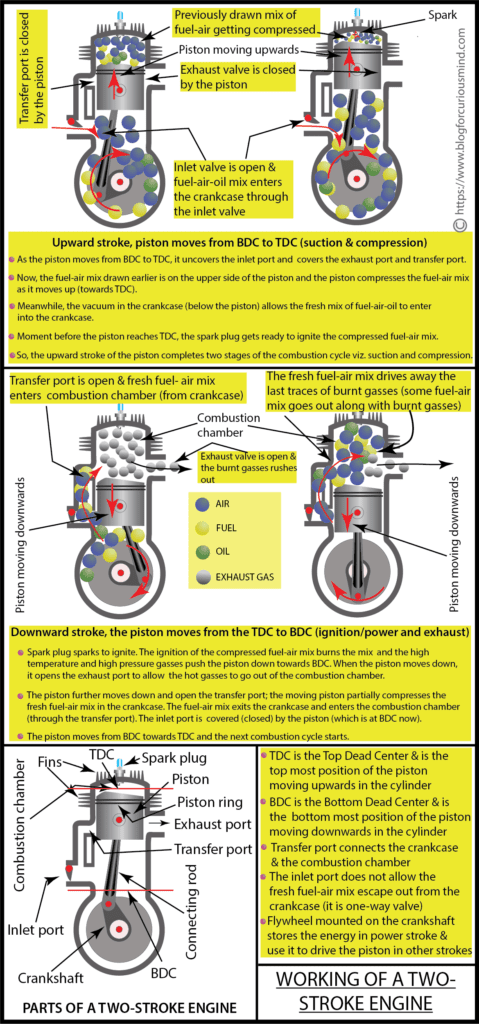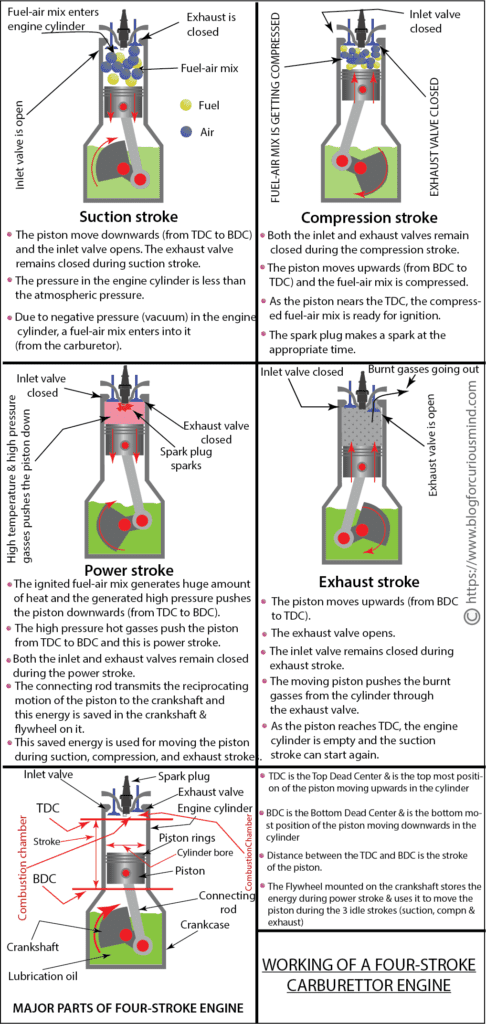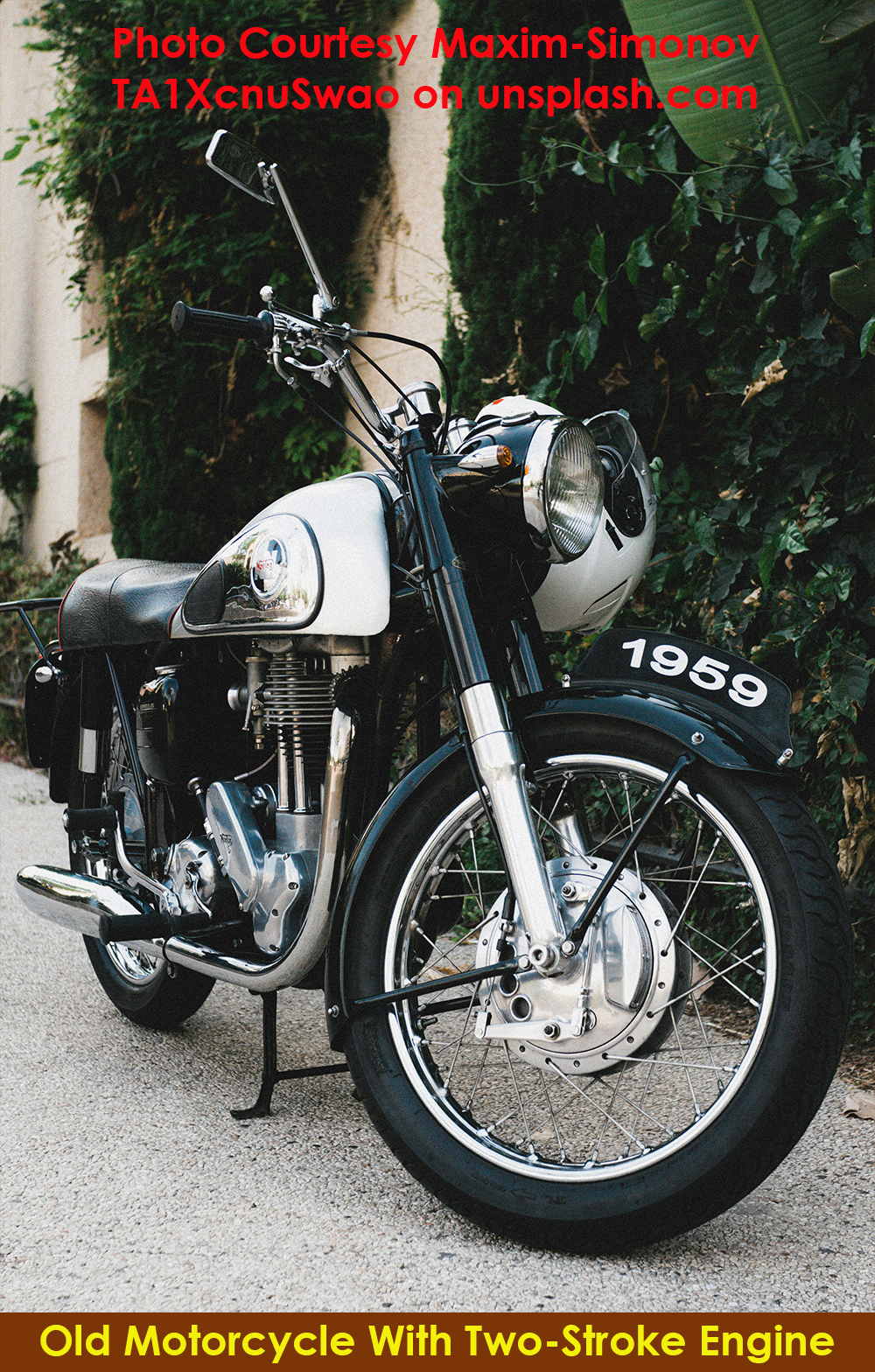Introduction
Today’s generation may ask what a two-stroke engine motorcycle is. Or even the basic question ‘What is a two-stroke engine?
But a few decades back the two-stroke motorcycles ruled the world. It was the favorite of both riders and motor mechanics due to its simple construction and the sound or feel it gave to the riders. Many motorcycle riders were happy about the noise produced by a two-stroke engine.
So, who killed the two-stroke engine. And why have motorcycle manufacturers switched over to the four-stroke engine?
We shall discuss the following subtopics during the article:
- Good and bad about two-stroke engines
- Why the two-stroke engines were killed
- Are the two-stroke engines completely banned
- What is the future of two-stroke engines
- What are DFI two-stroke engines
Good and bad about a two-stroke engine
Both two-stroke and four-stroke engines are internal combustion (IC) engines and any IC engine should undergo the following four stages to complete one combustion cycle.
- Suction
- Compression
- Ignition
- Exhaust
In an IC engine, the piston reciprocates up and down in the engine cylinder. When the piston moves up, its topmost position in the engine cylinder is called the top dead center (TDC). When it moves down, the bottom-most position is called the bottom dead center (BDC). The movement of the piston from TDC to BDC or BDC to TDC is called a stroke.
The piston is connected to the crankshaft through a connecting rod. The connecting rod and crankshaft together convert the reciprocating motion of the piston into the rotational motion. For every two strokes of the piston, the crankshaft makes one rotation.
A two-stroke engine completes one combustion cycle in two strokes or one crankshaft revolution. A four-stroke engine completes one combustion cycle in four strokes or two revolutions of the crankshaft. The working of two-stroke and four-stroke engines is explained in the images below.


Good about a two-stroke engine
Consistent and higher power
Since a two-stroke engine has one power stroke for every crankshaft rotation, it produces consistent and higher power. On the other hand, a four-stroke engine produces one power stroke per every two revolutions of the crankshaft. Due to this, the two-stroke motorcycles could accelerate quickly. They produce a sharp, loud, and distinct sound.
Simple and economical construction
A two-stroke engine cylinder has ports for the inlet of fuel-air mix and exit of burnt gasses. The moving piston opens and closes these ports. So, a two-stroke engine does not need inlet and outlet valves and their complex parts.
This makes the construction of a two-stroke engine simple and lightweight. A two-stroke engine has a better power-to-weight ratio and costs less due to its simple construction and low number of parts.
If the two-stroke engine gives steady power delivery, lightweight, enjoyable sound, and light on the wallet, why were they discontinued and disappeared? Continue reading to know.
Bad about a two-stroke engine
Low fuel economy
In a two-stroke engine, the compression of the fresh fuel-air mix starts a split second before the piston closes the exhaust port. In fact, the fresh fuel-air mix drives out the last traces of burnt gasses. However, while doing so, a part of the fresh fuel-air mix also goes out.
This not only pulls down the fuel efficiency but also increases the toxic level of the exhaust. This problem is not there in a four-stroke engine, since it has a dedicated exhaust stroke.
Bad emission
A normal two-stroke engine uses an oil-mixed fuel for lubrication. The fuel-to-oil mixing ratio can be approximately 40:1 (25 ml of oil in one liter (1000 ml) of fuel). This oil becomes part of the emission either by burning along with the fuel or as droplets of un-burnt oil in the emission.
So, the exhaust gasses emitted by a two-stroke engine will be thick and white due to oil burning and unburnt fuel. Also, it contains toxic elements harmful to animals, birds, humans, and the environment. Obviously, the exhaust gasses emitted by a two-stroke engine do not meet the standards for emission set by EPA (Environmental Protection Agency).
Running expenses
The requirement of lubrication oil per mile of motorcycle run is higher for a two-stroke engine than a four-stroke engine. Also, the loss of fuel in a two-stroke engine brings down its fuel efficiency. So, running a two-stroke motorcycle is expensive.
Lubrication system
A two-stroke engine depends on the oil mixed in the fuel for its lubrication which is not efficient. Due to a poor lubrication system, a two-stroke engine wears out much faster than a four-stroke engine. The dedicated lubrication system of a four-stroke engine lubricates and maintains the parts better.
Loss of fuel and pollution level
The fuel that goes out along with the exhaust can be up to 15% or more. This loss of fuel and the pollution level was acceptable before 1980. Back then the EPA emission norms were not strict and fuel was comparatively cheaper. But today with strict emission laws and high-cost fuel it is not acceptable.
Why the two-stroke engines were killed?
Two reasons for killing two-stroke engine motorcycles
- The two-stroke motorcycle manufacturers were unable to limit the pollution level of the exhaust emitted from it and bring it within the new emission standards set by the government agencies. So, the motorcycle manufacturers had no alternative but to switch over to four-stroke engine motorcycles.
- Another issue is the low fuel efficiency of two-stroke engine motorcycles and this gained importance due to rising oil prices at the international level.
Are the two-stroke engines completely banned?
Some countries allow two-stroke engines on equipment like lawn movers, snowmobiles, boat outboard engines, or race motorcycles since they do not run continuously like a motorcycle. The two-stroke race bikes are restricted to race tracks only and are not allowed on streets and roads.
What is the future of two-stroke engines?
Fortunately, the future of two-stroke engine motorcycles is not completely dark. Hopefully, they may gain their relevance once again.
The research and development of a product is a continuous process and the researchers have put efforts into solving the twin problems of emission and fuel loss in the two-stroke engine. The researchers have come up with two-stroke engines with Direct Fuel Injection (DFI) and Indirect Fuel Injection (IFI). They are still in the development stage.
What are DFI and IFI two-stroke engines?
In a DFI two-stroke engine, the intake port, and transfer port are used only for drawing air into the crankcase and combustion chamber. The fuel is directly injected into the combustion chamber, but only after the exhaust port is fully closed. This will eliminate the loss of fuel going out with the burnt gasses.
At the time of injecting the fuel into the combustion chamber of the engine, the piston is nearing the TDC, the air is almost compressed, and the piston may not be able to compress the air-fuel mix satisfactorily. To solve this issue, the fuel is injected into the cylinder at high pressure. The fuel has to get atomized, mixed with air, compressed, and become ready for ignition in the time available between the time the exhaust port is closed and the spark plug ignites.
In the IFI two-stroke engine, the fuel is injected before the closure of the exhaust port and the timing of fuel injection ensures the fuel will not reach the exhaust port when it is still open. The IFI allows more time for the fuel-air mix to get compressed and a normal fuel injector can be used.
The lubricating oil is directly injected into the crankshaft bearing and the fumes of this oil will take care of lubricating the piston and the cylinder. The oil is delivered by an electronically managed lubricating oil pump.
The fuel injectors used in a DFI two-stroke engine are more sophisticated compared to the ones used in a four-stroke engine since they need to inject at high pressure. It also needs a much more powerful ECU (Engine Control Unit) compared to a four-stroke engine for managing the wider range of two-stroke engine speeds.
These sophistications pushed the cost of a DFI two-stroke engine high. An expensive two-stroke DFI engine removes the basic advantage of a two-stroke engine viz. low cost and simple construction. Nobody may buy a two-stroke DFI engine motorcycle if it is more expensive than a four-stroke engine motorcycle.
DFI two-stroke engines were successfully used in Mercury outboard marine engines. However, the performance demand from an outboard engine is very moderate when compared to the high performance expected by a motorcycle.
Let us hope that the research and development continue and a cost-effective and simple DFI two-stroke engine that conforms to the emission standards will become a reality soon.
You may want to read the following articles.
What does a choke do on a motorcycle
Terms used in motorcycle specifications
Conclusion
We had a detailed discussion on ‘why the two-stroke engine motorcycles are killed’ and related topics. Hope this article was able to answer some of your questions on two-stroke engines.

